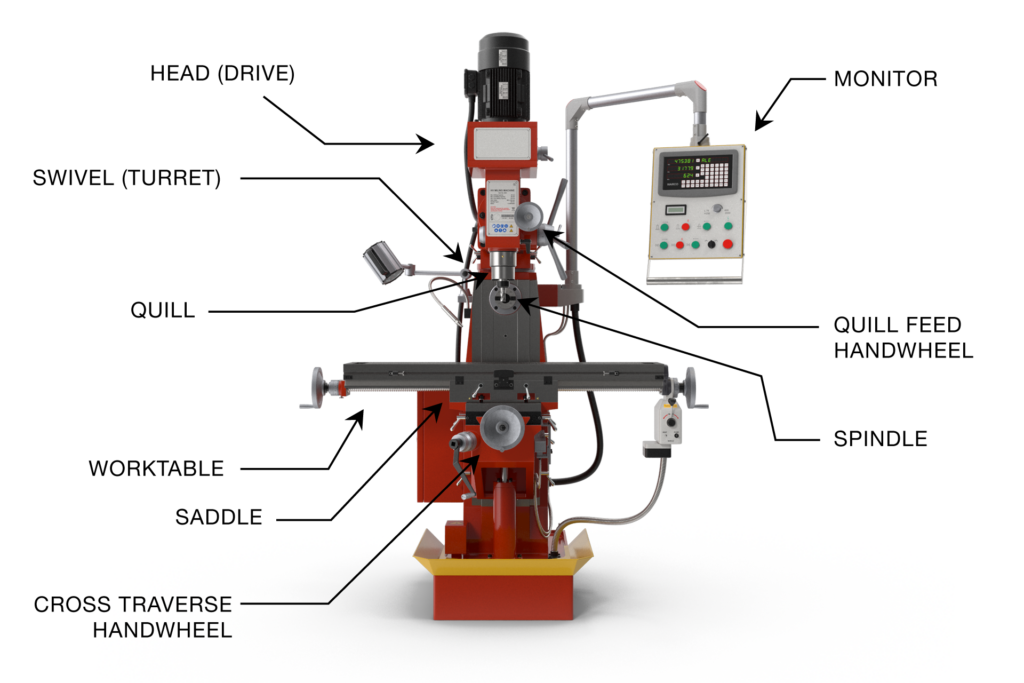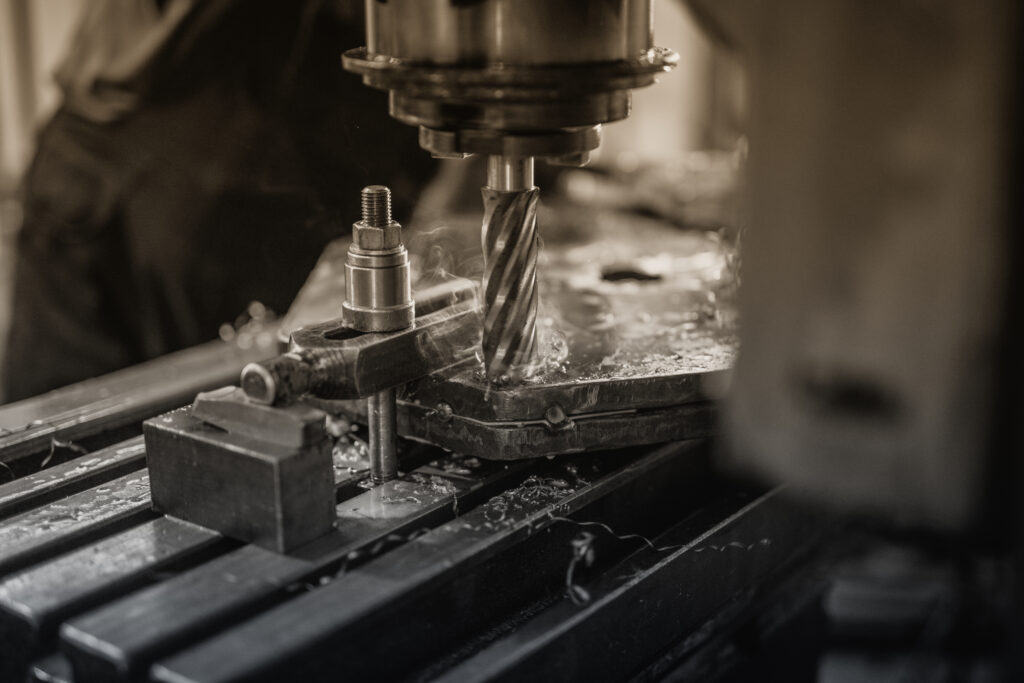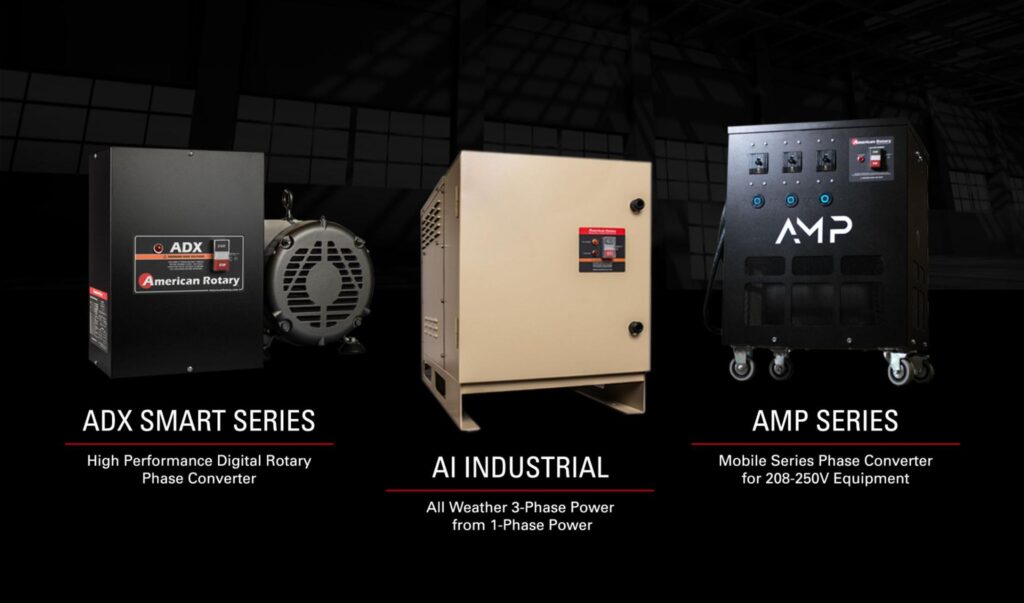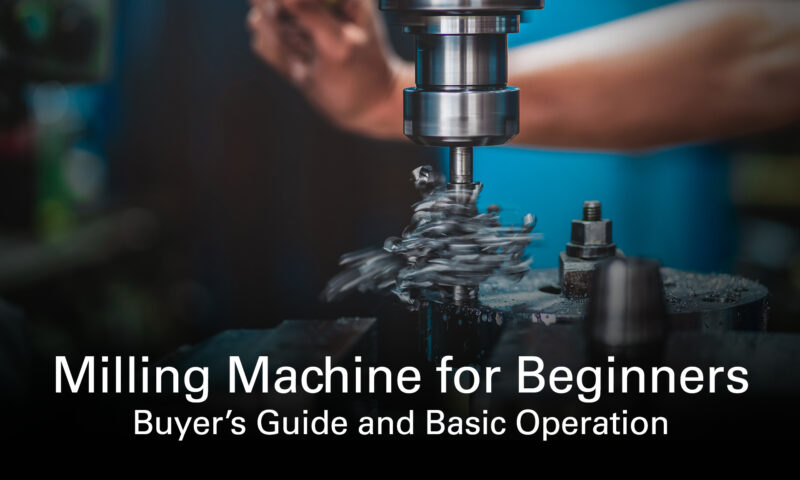Learning how to use a milling machine is an important step for any beginning machinist. With precision metal-cutting capabilities, a mill (along with a lathe) is a must-have for any machine shop.
Get to know this vital machine with this buyer’s guide and overview of basic operation.
Parts of a Milling Machine

By rotating a cutting tool, or spindle, against your workpiece, a mill can cut metal for a wide range of complex parts. Here are the key parts you need to know:
Head (Drive) – Houses the motor and drive mechanism that powers the spindle.
Monitor – Displays essential information and settings, including spindle speed, power feed rate, and tool positioning.
Swivel (Turret) – Rotates the spindle horizontally or vertically, providing flexibility in machining various angles and contours.
Quill Feed Handwheel – Controls the vertical movement of the quill, which holds the cutting tool. Turn to adjust the depth of tool penetration into the workpiece.
Quill – Vertical shaft attached to the spindle. Moves up and down for accurate cutting tool position.
Spindle – Rotating shaft that holds and rotates the cutting tool. Provides the primary motion for cutting metal workpieces.
Worktable – Secures the workpiece. Adjusts vertically, horizontally, or angularly to position the workpiece relative to the cutting tool.
Saddle – Supports and guides the movement of the worktable along the machine’s bed.
Cross-Traverse Handwheel – Controls the lateral movement of the worktable and saddle assembly, allowing precise positioning of the workpiece under the cutting tool.
Safety

A mill is a powerful machine that commands respect. If you can’t be bothered to take proper precautions, you won’t last long in the machining discipline. So before we talk about basic operation, we have to talk about safety.
First off, always wear your PPE. Safety glasses and steel-toed boots at all times.
OK, that’s what you must wear. Now here’s what to avoid wearing: anything that might get caught in the machine and pull you toward it. You want to cut metal, not skin and bones.
Therefore:
- No loose clothing of any kind
- No untucked shirts
- No jackets
- No long sleeves (or roll ‘em up tight)
- No necklaces, wallet chains, or anything hanging out
- No leather or fabric watch bands – if you wear a watch, use a metal bracelet
- No gloves – This may be unexpected, but these can also get caught in the machine, and a little cut on your hand is a lot better than losing an arm.
- No rags near the machine either unless the machine is locked out.
- Long hair always tied back securely
The other factor of the safety equation is learning and always following safe operation. Lock out the machine before making any adjustments.
Types of Milling Machines
Milling machines come in various types, each designed for specific machining tasks and applications. Here are some of the common ones you might encounter:
Bridgeport / Knee Mill
The standard knee mill (often called Bridgeport style for the best-known manufacturer) features a vertically adjustable spindle mounted on a stationary column. The worktable moves horizontally along the saddle and vertically along the knee, providing flexibility in machining various shapes and sizes of workpieces.
Vertical Mill
A vertical milling machine is a broader category that features a vertically oriented spindle. It may lack the knee and saddle assembly.
Horizontal Mill
Here, the spindle is positioned horizontally, perpendicular to the worktable. This setup allows for machining of workpieces along both the X and Y axes, making it suitable for production milling and heavy-duty cutting operations.
CNC (Computer Numerical Control) Milling Machine
CNC mills are automated machines controlled by computer programs. They offer precise control over cutting parameters to perform complex machining tasks with high accuracy and repeatability.
Bed Mill
A bed mill has a stationary bed or base that supports the workpiece and a vertically adjustable spindle mounted on a movable gantry or column. This design provides stability and space for heavy-duty or large-scale milling operations.
Turret Mill
A turret milling machine is a type of vertical milling machine that has a head that can swivel on a vertical axis, allowing the cutting tool to approach the workpiece from different angles offering added versatility over a traditional knee mill.
Universal Milling Machine
A universal milling machine provides a swiveling table that allows for machining workpieces at various angles. It is a versatile tool for machining complex shapes and contours, making it suitable for diverse applications.
Which Type Is Right for You?
For beginners, starting with a Bridgeport-style standard knee mill makes sense. The versatility, variety of informational resources, and relative ease of operation offer a solid foundation for learning milling fundamentals and mastering basic machining techniques.
What to Look for in a Milling Machine

A new milling machine looks pretty darn cool. But evaluating a mill is about a lot more than checking out the sleek finish. Let’s run down the most important aspects to ensure you get the performance and versatility you need.
Size
A mill’s size—ranging from minis and benchtops, to standard-sized Bridgeport style, to larger bed and universal mills—directly impacts the machine’s capability and versatility.
To determine the size you need, consider:
- Maximum size of your workpieces – Make sure the worktable and spindle travel adequately accommodate your max dimensions.
- Types of cutting tools – Check the spindle capacity to ensure it can accommodate the cutting tools for your machining tasks.
- Your workspace dimensions – Will there be enough clearance around the machine for safe operation and ease of access to the workpiece?
- Room for growth – A milling machine that’s slightly larger than what you might currently need provides flexibility to avoid the need for an immediate upgrade as your skills and projects evolve.
Our take on size? Opt for a medium-sized milling machine, such as a 9” x 42” knee mill. You’ll get a balance between versatility, ease of use, and availability of accessories and tooling.
Features
Here are some essentials for optimal performance and versatility:
- Digital Readout (DRO) system – Provides real-time feedback on the position of the milling machine’s axes, enhancing accuracy and productivity. A huge plus to help reduce setup time and minimize machining errors.
- 1 to 2 horsepower rating – Provides sufficient motor capacity to handle basic milling tasks without being overly powerful.
- Variable speed control up to 3,000 RPM – Allows for flexibility in machining various materials and using cutting tools.
- Mid-size table – A table size of 6 inches by 26 inches or up to 9 inches by 49 inches should accommodate a good range of workpiece dimensions and beginner machining capabilities.
- Standard R8 spindle type – The spindle type and taper determine the compatibility of cutting tools and tool holders. Other types include ISO, and CAT. But R8 is the most common, typically found on Bridgeport-style knee mills—and offers the best combination of versatility, affordability, and ease of use.
- 3 – 5 inch spindle quill travel – Spindle quill travel determines the vertical movement of the cutting tool, allowing for precise depth control and hole drilling capabilities. Up to 5 inches should be good to handle common beginner machining tasks such as counterboring and reaming.
- Tilting spindle head – A swiveling or tilting head is a nice-to-have that increases machining flexibility and facilitates complex machining operations, such as angled cuts, grooving, and contouring.
Best-Bet Brands
There’s no shortage of mill manufacturers and brand names. And it’s tempting to pick just based on price. But you’ll get what you pay for.
Given the rugged requirements of a milling machine, you’re better off investing in a reputable brand. You’ll enjoy better build quality, performance, and reliability if you choose from proven brands including:
- Bridgeport – Synonymous with the classic knee mill design, offering robust construction, precision engineering, and versatility.
- Jet – Go-to name in metalworking with a range of milling machines tailored to different machining needs and budgets.
- Grizzly – A well-established brand known for its wide variety of metalworking machinery, valued for quality construction, precision components, and competitive pricing.
- Clausing Industrial – Trusted provider of precision equipment with rugged construction, versatility, and reliability for a variety of metalworking applications.
Basic Operation
Now that you have a sense of what’s available, let’s take a look at what you need to know to get started using your mill.
Your mill may not be perfectly aligned when you first encounter it. These imperfections can lead to inaccurate results. So first, you need to set up the machine in two critical ways. Watch the video above for a full demonstration.
Tramming the Head
Adjust the head so that the angle of your spindle to the table is a neat 90 degrees.
- Attach a dial indicator to the spindle. You can adapt an indicator arm for this purpose.
- With the head zeroed out, check the measurement at one end of the table. Then swing the indicator to the other end of the table and check that.
- If these measurements are off by anything more than a thousandth, you need to tram the head.
- Slightly loosen the bolts on the head. Tap the head with a rubber mallet to offset the difference.
- Check your measurements again. Repeat the tapping as necessary.
- Once you’re within a thou, tighten the bolts bit by bit. Alternate by bolt, being careful not to mess up the adjustments you just did.
Installing and Indicating the Vise
Make sure your vise jaw is properly aligned to the head to enable parallel cuts. Indicating a vise can be a complicated process. But here’s a relatively simple method.
- Clean the bottom of your vise. Remove any dings with a deburring stone.
- Bolt the vise to the center of your table.
- Put a parallel into the jaws that’s at least as long as the space between the vise’s mounting bolts. Those bolts are the pivot points for your adjustments.
- Loosen the bolt on only one side of the vise for controlled adjustments.
- Move the vise across the table, checking the measurements with a dial indicator attached to the spindle axis along the way.
- Anytime the measurements are more than a few thou off, tap the vise with a machinist’s hammer until the dial indicator shows alignment.
- When you’re aligned all the way across the table, tighten the bolts. Do a little bit at a time.
- Double-check your results and adjust as necessary.
Touching Off
Your first approach with the end mill to cut metal is called touching off. It’s your chance to make sure everything is in order to get precise machining results.
Here’s an overview of the process. Watch the video above for a complete demonstration (plus some insights on selecting good end mills).
- Put your workpiece in your vise. An aluminum block is a good material to get started. Use parallels if necessary to raise it up.
- Bring the head down until it’s just above the workpiece.
- Wind out the vise so that the workpiece’s outside edge is now lined up with the cutting tool.
- Start your spindle at a middle-of-the-road speed—about 800 rpm is a good place to start.
- Use your quill feed handwheel to bring the head down slowly. Watch and listen for the very first contact with the workpiece.
- Wind the vise back out.
- Set your DRO to 0 at this point.
- You’re zeroed out and ready to cut!
Cutting to Spec
Once you’ve got everything lined up and zeroed out, you can make cuts as specified.
- Use the handwheel to set your depth of cut.
- For aluminum, you can set it at 0.050 inch (50 thou). Other materials will require shorter depth of first cut and more passes.
- Lock in the quill. The measurement may change slightly on your DRO when you lock it in, so you may need to adjust this a few times for precision.
- Apply a bit of cutting fluid and feed in your workpiece.
- You may need to pause to remove chips along the way with a brush or compressed air.
To get to your final spec and get a good surface finish, you will probably need to do multiple passes instead of doing the whole cut in one go. But don’t worry; doing multiple passes makes for good practice—and it’s good for tool life, too.
One More Run-of-the-Mill Issue

OK, now you’ve got a good base of milling machine knowledge.
But here’s one more important aspect to consider: how to power your mill. A mill powered by three-phase electricity will offer smoother, more efficient operation. The only question is how to get that 3-phase in your shop.
In that case, a rotary three-phase converter is a great solution. It converts the typical single-phase electricity service into balanced three-phase power. A USA-made American Rotary phase converter can even provide smooth power for your whole shop—including both 3-phase and single-phase machines.
Contact us for help sizing a converter for your needs. And good luck in your milling adventures!



